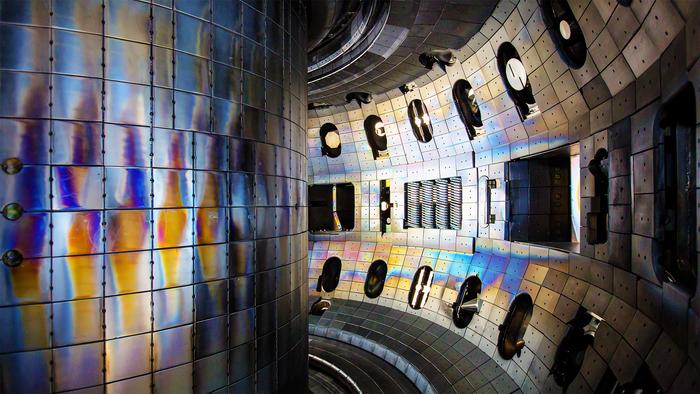
To develop a viable fusion power system, a comprehensive understanding of plasma interactions within fusion vessels is paramount. Plasma, the hot, charged state of matter required for fusion reactions, can exhibit complex behaviors, particularly when reaching extreme temperatures. During experiments, plasma can produce energetic particles that collide with the walls of a fusion vessel, leading to certain atoms embedding themselves in those walls. This phenomenon poses a significant challenge, especially concerning the retention of fuel materials, which can impact the overall efficiency and safety of future fusion reactors.
Research conducted by a leading team at Princeton Plasma Physics Laboratory has focused on the behavior of deuterium, a form of hydrogen considered a promising fuel for fusion reactions. During their study, researchers scrutinized the interactions between deuterium and boron-coated graphite—the material used in constructing the walls of the DIII-D tokamak vessel. The findings highlighted the intricate dynamics at play, particularly the extent to which deuterium can become trapped within the boron and graphite, thereby affecting the radioactive material’s buildup in the system.
Shota Abe, a prominent physicist involved in the research, emphasizes that minimizing the amount of fuel trapped in the walls is critical for maintaining a clean operational environment for fusion reactions. The presence of deuterium within the structural walls of a fusion device can lead to the accumulation of unwanted radioactive materials, resulting in complexities that may hinder the overall function of the reactor. Managing this fuel retention is not merely a technical concern but a significant aspect influencing the regulatory compliance of future fusion power plants.
The study conducted by Abe and colleagues outlines the interactions between deuterium and the boron layer and how this affects fuel retention. While boron is often employed to mitigate impurities in plasma, the long-term implications of using boron-coated materials remain unclear to researchers. The study sheds light on these interactions, revealing that while boron could be advantageous, it may also inadvertently contribute to additional challenges regarding fuel retention within reactor walls.
Through advanced experiments conducted at DIII-D, a premier fusion research facility, researchers discovered that the primary culprits behind deuterium trapping were not the boron coatings but rather carbon impurities. Even minute concentrations of carbon significantly increased the amount of deuterium that adhered to the surfaces in question. This finding is significant, given that carbon is a constituent of the graphite used for the tokamak walls. With carbon being a problematic element in fusion systems, this research emphasizes the urgent need to minimize its presence within reactor environments.
PPPL’s research illustrates that the fusion community must capture and analyze every possible variable affecting deuterium retention to maximize operational efficiency in future reactors. The binding interactions between carbon, boron, and deuterium can lead to challenges that could impede fusion processes, making it essential for scientists and engineers alike to innovate strategies to offset these effects. Achieving an enhanced understanding of these parameters lays the groundwork for ultimately transforming fusion power from theory into practice.
Working collaboratively, the research team included several notable institutions and experts across the country contributing to the findings. The collective knowledge and methodologies employed in this study demonstrate the collaborative effort needed to tackle the multifaceted challenges facing modern fusion research. It becomes increasingly evident that no one institution can singularly navigate the complexities of making fusion energy a reality. Instead, it requires a concerted effort among institutions like Princeton University, General Atomics, and others alike, each bringing forward specialized expertise and insights.
Researchers engaged in this project employed an array of modern tools and analytical methods to characterize deuterium retention under various conditions. Their findings indicate that the total quantity of deuterium trapped is directly connected to how carbon interacts with both boron and deuterium. This realization has far-reaching implications for the design and operation of future reactors like ITER, where minimizing such impurities may play a pivotal role in ensuring the success of commercial fusion systems.
As the research progresses, a potential path for innovation emerges. By capitalizing on advanced materials and new technologies, the fusion energy field can evolve towards optimal configurations reducing corrosive contaminants that hamper reactor performance. The ultimate aim is to develop fusion as a sustainable and commercial energy source that could provide clean energy solutions while navigating the challenges posed by traditional nuclear power generation methods.
The ongoing research uncovers not just the immediate implications for material science and engineering but inherently fuels a more enormous ambition to promote fusion’s role in clean energy systems. Embracing a future reliant on fusion necessitates developing better technologies and enhancing our scientific comprehension of nuclear interactions. As pivotal discoveries unfold, the fusion research community remains dedicated to unravelling these intricate challenges, creating a pathway towards a sustainable energy landscape that future generations can rely upon.
In conclusion, the journey toward an efficient fusion power system is laden with technical complexities requiring continued collaboration and innovation. Researchers are poised at the forefront of this field, grappling with deuterium retention issues and its implications for reactor design. As scientists delve deeper into the relationships between fuel materials and vessel walls, prospects for a more energy-efficient and sustainable future through fusion energy remain bright. Such endeavors promise not only to meet energy demands globally but to secure enduring solutions towards a cleaner, environmentally friendly energy paradigm.
In the quest for harnessing fusion energy, understanding and addressing the challenges posed by materials such as boron and carbon in fusion reactors critically determines the trajectory of ongoing developments in this innovative energy sector. It is this kind of research which will ultimately forge the pathway to realizing fusion power as a truly practical energy source in the modern world.
Subject of Research: Investigation of deuterium retention behaviors in boron-coated wall materials of fusion reactors.
Article Title: Deuterium retention behaviors of boronization films at DIII-D divertor surface.
News Publication Date: October 2023.
Web References: Nuclear Materials and Energy
References: https://www.energy.gov/science/doe-explainstokamaks
Image Credits: Credit: General Atomics
Keywords
Applied sciences and engineering, Nuclear engineering, Fusion reactors, Carbon, Experimental physics, Plasma physics.
Tags: boron-coated graphite in tokamakschallenges of fuel retention in fusionclean operational environments for fusion reactionsdeuterium behavior in fusion experimentsdynamics of fusion vessel materialsefficiency of fusion power systemsenergetic particles in plasma physicsfuel accumulation in fusion vesselsminimizing fuel trapped in reactor wallsplasma interactions in fusion reactorsPrinceton Plasma Physics Laboratory researchsafety implications of fusion reactor design






